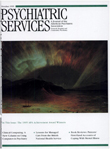A national survey on seclusion and restraint in state psychiatric hospitals
Abstract
OBJECTIVES: State psychiatric hospitals across the U.S. were surveyed to develop national normative data on the incidence of seclusion and restrain and of injuries to patients and staff resulting from aggression by patients. METHODS: A survey instrument was sent to 225 state hospitals requesting information for a one-year period on the number of patients placed in seclusion or restraint, the number of discrete incidents of seclusion and restraint, the number of hours patients spent in seclusion or restraint, and the number of injuries to patients and staff attributable to aggression by patients. Rates of seclusion, restraint, and injuries were calculated to control for variation in hospital censuses. Percentile ranks for the various rates were calculated to allow hospitals to compare their rates. RESULTS AND CONCLUSIONS: A total of 101 state hospitals in 44 states and the District of Columbia returned the survey. In general, smaller hospitals had higher rates of seclusion and restraint. However, large standard deviations in the mean rates suggested considerable variability between hospitals in the sample. Small positive correlations between rates of seclusion and rates of restraint suggested that the hospitals did not use of the two interventions exclusively.
Access content
To read the fulltext, please use one of the options below to sign in or purchase access.- Personal login
- Institutional Login
- Sign in via OpenAthens
- Register for access
-
Please login/register if you wish to pair your device and check access availability.
Not a subscriber?
PsychiatryOnline subscription options offer access to the DSM-5 library, books, journals, CME, and patient resources. This all-in-one virtual library provides psychiatrists and mental health professionals with key resources for diagnosis, treatment, research, and professional development.
Need more help? PsychiatryOnline Customer Service may be reached by emailing [email protected] or by calling 800-368-5777 (in the U.S.) or 703-907-7322 (outside the U.S.).



